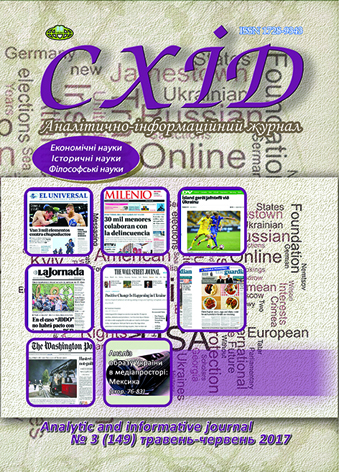The phenomenon of hypertext in Internet and Philosophy of postmodernism
DOI:
https://doi.org/10.21847/1728-9343.2017.3(149).108343Keywords:
Hypertext, hyperlinks, computer discourse, semantic unit, Internet, Virtual consciousness of the Internet, postmodernityAbstract
The article contains general definition of the phenomenon of hypertext and the Internet in a virtual consciousness philosophy of post-modernism. Describes the phenomenon of hypertext as nonlinear forms of computer and literary texts, its structural units and the main aspects of the organization of hypertext.
The article contains the detailed analysis of publications on the issue of hypertext and the history of investigation of this problem.
The specific features which allow defining of hypertext as the brand new phenomenon are analyzed in the article. Among them we can mention the following points:
- Hypertext is constantly updateable, amendable, editable;
- Hypertext has neither any set beginning or the end nor any hierarchical structure;
- Hypertext has decentralized nature;
- The specific features of hypertext are manifested in text transformations. If an "ordinary" text has linear character, and one can move in its "area" only in the directions limited by one and the same space, then rhizomorphic hypertext opens new "transverse" changes in the text Universe. The way of organizing of text in Internet corresponds to the major ideas of "nomadology" and "Rhizome" developed by Gilles Deleuze and F?lix Guattari in their Capitalism and Schizophrenia (1972-1980) project.
Postmodernist electronic hypertext is a phenomenon by its nature opposite to modernist printed text. This allows us to consider hypertext as one of the features of coming of "post- Gutenberg era".
Hypertext fundamentally changes the way of construction of text environment - to replace the one-dimensional text comes multi-dimensional. In the phenomenon of the global information network, created on the basis of hypertext technology, - intertextual fiber, series of texts, which intercross with other texts, produce new texts.
In conclusions of the article - the characterization of hypertext as postmodernist phenomenon is given and the major views of postmodernism which are represented in hypertext - plurality, decentration, fragmentariness, intertextuality - are provided.Downloads
References
Lyotard, J.F. (1998), The Postmodern Condition (“Sostoyanie postmoderna”), Institute of experimental sociology, Moscow, Aleteya, Saint-Petersburg, p.14 (rus, translation from French)
Baudrillard, J. (2001), The System of Objects (“Systema Veshchey”), Moscow, Rudomino, p.64 (rus, translation from French)
Bush, Wannevar (1945), As we may think, available at: http://worrydream.com/refs/Bush%20-%20As%20We%20May%20Think%20(Life%20Magazine%209-10-1945).pdf
Hypertext. Definition of the concept (2011), Optimal communications (The epistemic resource of the Academy of Media Industryand the Department of Theory and Practice of Social Connectivity of the RSUH), available at: http://jarki.ru/wpress/2011/02/16/1872/
Nelson, T. (1993), Literary machines, CA: Mindful Press, Sausalito (eng).
VASSAR MISCELLANY NEWS (February 3, 1965), Prof. Nelson Talk Analyzes P.R.I.D.E. by Lauren Wedeles, availabe at: http://faculty.vassar.edu/mijoyce/MiscNews_Feb65.html
Epstein, V.L. (1991), Hypertext is a new paradigm of informatics, Automation and Telemechanics. № 11. pp. 3-16 (rus).
Beletsky, V. S. & Biletsky, V. V. (2004), Globalism as a phenomenon of the modern world and its influence on the transformation of the individual (socio-philosophical aspect), Donetsk Scientific Journal of the Scientific Society. Shevchenko, Vol. 5. Donetsk, pp. 46-52 (ukr).
Prosalova, V.A. & Berdnik, O.S. (2010), Intertextuality of artistic text: textural and receptive aspects, Nord-Press, Donetsk, 152 p. (ukr).
Marshall, McLuhan (2003), The Gutenberg Galaxy: The Making of Typographic Man), Kiev, Nika-center, p. 110 (rus).
Eco, Umberto (1997). Under Network (interview with Lee Marshall), Art of Cinema, Мoscow, 1997, 9, p.136, available at: http://lib.ru/UMBEKO/kinowed97.txt (rus).
Kuznetsov, M. (1997), Virtual reality: sight from the viewpoint of Philosopher, Virtual reality: Philosophic and psychological aspects, Moscow, p.87 (rus)
Kerimov, T. (1998), Nomadology, Modern philosophic vocabulary, in Kemerova V.E. (Ed.), 2nd edition, Moscow, Panprint, p.571 (rus)
Belozerova, N. (2000), Theory of hypertext: illusory contradiction, Tyumen State University Bulletin, 4, p. 65 (rus)
Intertext, available at: http://ru.wikipedia.org/wiki/Интертекст/ (rus)
Kristeva, J. (1967), Bakhtine, Le mot, le dualogue et le roman, Critique, 239, avril 1967 (fr)
Kristeva, J. (1970), Une poétique ruinéee, La poétique de Dostoїevski. Paris, Seuil (fr)
Kristeva, J. (1969), Semeiotikē. Recherches pour une sémanalyse. Paris, Seuil (fr)
Kristeva, J. (1970), Le texte du roman, La Haye, Mouton (fr)
Vizel, M., The last novels of Italo Calvino as the examples of hypertext, part “Hypertextuality and post-modernity” available at: http://www.netslova.ru/viesel/viesel.htm#o4/
Karymova, M. (2002), Hypertext in Philosophy of Postmodernism, Bulletin of Tyumen State University, pp. 64-69 (rus)
Electronic labyrinth, available at: http://www2.iath.virginia.edu/elab//hfl0037.html
Hassan, Ihab (1987), Making sense: the triumph of postmodern discourse, New literary history, vol. 18, №2, pp. 445-446. DOI: 10.2307/468739.
Downloads
Published
How to Cite
Issue
Section
License
Copyright (c) 2017 Petro Krasnopyorov

This work is licensed under a Creative Commons Attribution-NonCommercial-NoDerivatives 4.0 International License.
1. Authors bear responsibility for the accuracy of facts, quotations, numbers and names used.
2. Manuscripts are not sent back.
3. The publisher does not always agree with the authors' opinion.
4. The authors reserve the right to authorship of the work and pass the first publication right of this work to the journal under the terms of a Creative Commons Attribution-NonCommercial-NoDerivatives 4.0 International License. This license allows others to distribute (copy) the published work for non-commercial purposes, provided there is mandatory attribution to its authors and a link to the first publication in our journal.
5. The authors have the right to conclude separate supplement agreements that relate to non-exclusive work distribution in the form in which it has been published by the journal (for example, to upload the work to the online storage of the journal or publish it as part of a monograph), provided that the reference to the first publication of the work in this journal is included.

